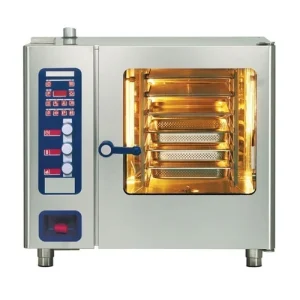The world of culinary excellence is constantly evolving, with chefs and food enthusiasts seeking innovative techniques and appliances to push the boundaries of gastronomy. Among the many groundbreaking advancements in professional kitchens, combi ovens have emerged as a true game-changer. Combining the functionality of convection ovens, steamers, and even grills, these versatile appliances have revolutionized the way chefs cook, bake, and create delectable dishes.
According to the Fact.MR’s Study, The global combi ovens market is valued at US$ 2.13 billion in 2023 and is forecasted to reach US$ 5.18 billion by the end of 2033, expanding at a CAGR of 9.3% over the next ten years.

In this blog, we will explore the emerging trends in combi ovens and how they are reshaping the culinary landscape.
- Precision Cooking:
One of the most significant trends in combi ovens is the emphasis on precision cooking. Modern combi ovens are equipped with advanced temperature and humidity controls, allowing chefs to achieve precise cooking results consistently. Whether it’s achieving the perfect sear on a steak, baking delicate pastries with an ideal crust, or gently cooking sous vide-style dishes, combi ovens provide unparalleled control over the cooking process. The precision cooking capabilities of combi ovens enable chefs to consistently deliver high-quality and consistent results, making them an indispensable tool in professional kitchens.
- Connectivity and Smart Features:
With the rise of the Internet of Things (IoT) and smart technology, combi ovens are becoming increasingly connected and feature-rich. Chefs can now remotely control and monitor their combi ovens using smartphones or tablets, allowing them to multitask and manage their kitchen operations more efficiently. From adjusting cooking parameters to receiving notifications and alerts, connectivity enables chefs to stay on top of their culinary creations with ease. Additionally, smart combi ovens can analyze data and provide insights to optimize cooking processes, improve energy efficiency, and enhance overall performance.
- Sustainability and Energy Efficiency:
In line with the growing focus on sustainability, combi oven manufacturers are incorporating energy-efficient features and designs. Combining steam and convection cooking methods, combi ovens reduce cooking times, resulting in significant energy savings. Furthermore, the precise humidity and temperature controls prevent food waste by ensuring optimal cooking results and minimizing overcooking or drying out. Some combi ovens also feature innovative water filtration systems, reducing water consumption and environmental impact. By embracing sustainability and energy efficiency, combi ovens play a vital role in promoting environmentally conscious practices in the culinary world.
- Enhanced Cooking Programs and Pre-Set Recipes:
To simplify and streamline culinary operations, combi ovens now come equipped with an extensive range of cooking programs and pre-set recipes. These programs and recipes are designed by renowned chefs and culinary experts, offering users a diverse selection of dishes and cooking techniques at their fingertips. By simply selecting a pre-set program, chefs can achieve consistent and professional results without the need for extensive culinary knowledge or expertise. This trend has made combi ovens more accessible to chefs of varying skill levels, allowing them to explore new flavors and experiment with different cuisines effortlessly.
- Compact and Space-Saving Designs:
As commercial kitchens strive to optimize space utilization, compact combi ovens have become increasingly popular. Manufacturers are developing smaller and more versatile models that can fit seamlessly into tight spaces without compromising performance. These compact combi ovens are designed to be stackable or modular, allowing chefs to expand their cooking capabilities while saving valuable kitchen real estate. The compact design trend has enabled restaurants, hotels, and catering services to maximize their kitchen efficiency, even in limited spaces.


